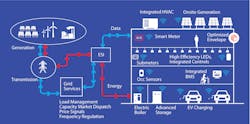In the past decade, the lighting industry has been bamboozled by visions of fully automated “smart” buildings and cities driven by artificial intelligence (AI) that magically optimizes energy and resource use and most other outcomes. This has been driven by a number of factors, including a persistent and reflexive reliance on technology to solve problems that are better solved by design, economics, and politics. It’s also a result of the fast-paced, relentless tech industry trying to own the slow, entrenched building industry. The lighting industry has not quite known what to make of this assault, but there are signs that the early marketing hype promulgated chiefly by larger companies is starting to show signs of feasibility. Now we might say that smart buildings are in fact the future of lighting, and that integrated controls are what make them smart. Despite being far from accepted mainstream practice, integrated controls are increasingly being implemented in a growing number of projects.
The self-running building fantasy narratives of the last decade or so haven’t given us a useful definition of what actually makes a building smart. Faced with monumental challenges to our climate, economy, and energy system, we can now say that a smart building is one that produces, uses, and transmits electricity; sends and receives data on energy use, building occupancy, and much more; and has integrated controls that make all of this possible. Indeed, use cases and how-to information will be center stage at this year’s Strategies in Light virtual conference.
Integrated building controls — where lighting, HVAC, and other systems work together to optimize building performance — are essential to building an equitable, resilient, decarbonized power infrastructure and meeting the challenges of climate change. In order to manage the recent and growing influx of renewable energy sources, balance the load on the grid, building systems and equipment must be able to collect and report data, respond to dynamic price signals, and talk to each other in a much more robust way than they currently do today. As one of the most important building systems, lighting plays a key role in the transition to a sustainable, resilient future.
The reasons lighting systems are an ideal vehicle for smart building systems are well understood — they’re typically evenly distributed, powered, and are steadily becoming smarter. Another important behavioral reason that lighting plays a key role is that it is the first and most visible use of energy. A building that uses light efficiently and well sends a positive signal to occupants.
A more important reason that lighting controls play a lead role in the evolution of smart buildings is that they rely more on occupancy-based controls than HVAC systems, which are largely schedule based. Schedules are typically set once and then generally ignored. It’s quite common to find schedule-based systems running when no one is in the building, wasting much energy. There are compelling reasons to use a lighting occupancy-sensor system to control many other building services, especially HVAC, as real-time data is a much better basis for managing energy. And actual real-time building energy use data enables many things, including load management, decarbonization, and outcome-based code.
Control systems have long been a weak link in the building industry, and as they become more complex, the challenges will only increase. But the main hurdles we face are not technological: They’re economic, behavioral, and cultural. Contracting business models in particular must evolve and adapt to face the reality of the enormous challenges we face today.
The entire value chain must understand how the evolving future of smart buildings can have a decisive impact on product roadmaps, strategic planning, and ability to adapt to the challenges of the lighting industry today. Strategies in Light 2021 presents a unique range of perspectives from the leading industry thinkers. Our speakers have been carefully curated to provide a 360° vision of the future of lighting and smart buildings.
Register now to join us for the online conference, which will be held from Aug. 24–25, 2021.
CLIFTON STANLEY LEMON is CEO, Clifton Lemon Associates, and Strategies in Light co-chair.
*Updated May 26, 2021 4:42 PM for speaker affiliation.
For up-to-the-minute LED and SSL updates, why not follow us on Twitter? You’ll find curated content and commentary, as well as information on industry events, webcasts, and surveys on our LinkedIn Company Page and our Facebook page.






